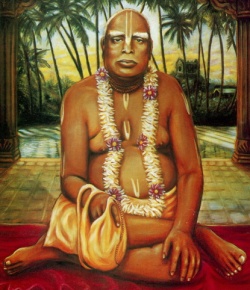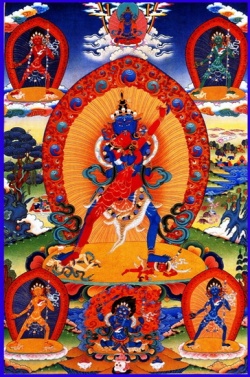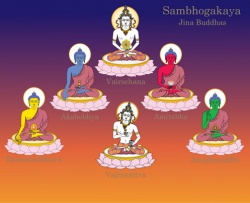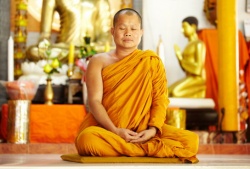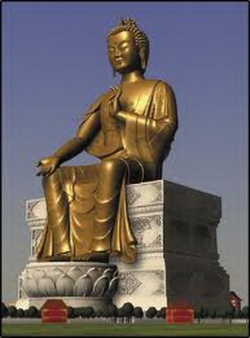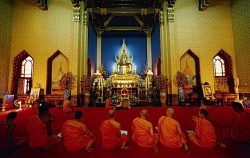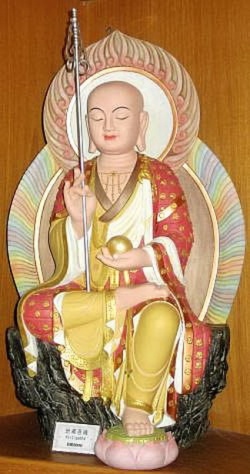The Ta Chih Tu Lun
The Ta Chih Tu Lun
Chapter 31 Chuan 19
Thirty-Seven Limbs of Enlightenment
Translated By Lewis Lancaster
Professor Lewis Lancaster has been deeply involved in Buddhist studies for many years. He began these studies while working for the Master of Theology degree at the University of Southern California, and went on to obtain the Ph.D. degree from the Department of Indian Studies at the University of Wisconsin, in Buddhist studies.
After completing the work at Wisconsin, Dr. Lancaster spent two years at the University of Washington in Seattle working with Leon Hurvitz and Edward Conze, before joining the Department of Oriental Languages at Berkeley in 1967. The courses he offers at the University of California at Berkeley are popular and his students, both graduates and undergraduates, are numerous. This year he is teaching an "Introduction to Buddhism", "Development of Buddhism in the Far East", "Reading of Chinese Buddhist Texts", and "Reading of Tibetan Buddhist Texts". Dr. Lancaster presently sits on the [[Board of Directors of the Society for Asian and Comparative Philosophy, and is a member of the Faculty Advisory Board of the Institute of Buddhist Studies in Berkeley.
As this issue of Vajra Bodhi Sea is released, Dr. Lancaster begins a research trip to Japan, Korea, and Southeast Asia sponsored by a grant from the American Council of Learned Societies, and a Faculty Research Fellowship from the University. He returns to resume his teaching duties in October.
PREFACE
The Ta Chih Tu Lun (T. 1509) is a commentary to the Pancavimsati-sahasrika-prajnaparamita-sutra and exists only in Chinese in a text attributed to Kumarajiva and said to have been composed by Nagarjuna.* Etienne Lamotte has already provided us with an excellent translation of the first thirty chapters in his La Traite de la grande vertu de sagesse de Nagarjuna. Several years ago I began to translate some of the sections not included in his work. However, I did not pursue the project when Prof. Lamotte wrote of his decision to publish at least one more volume of the commentary. When his Volume III appears, it will certainly provide the scholar with the annotation for which Lamotte is justly famous. Therefore, I have not felt it necessary to provide footnotes in this short section, which will appear in the Vajra Bodhi Sea.
My hope is that this English translation will be of interest to the readers until the more complete French translation appears.
L.Lancaster
For comments on the problem of authorship see my review of K. Venkata Ramanan’s
Nagarjuna’s Philosophy as Presented in the Mahaprajnaparamita sastra, in Philosophy
East and West Vol. XVIII, 1968, pp. 97–99.
Ta Chih Tu Lun
Composed by Bodhisattva Nagarjuna
Translated on Imperial Command by Kumarajiva,
a Kuchean monk in the service of the State of Latter Ch’in.
Chapter 31 Chuan 19
The Thirty-Seven Limbs Of Enlightenment
Sutra
Because the Bodhisattva. Mahasattva does not abide in dharmas he abides in the Perfection of Wisdom. Because of their non–arising, he should be endowed with the Four Applications of Mindfulness (smrtyupasthana). Four Right Efforts (samyak–prahana). Four Bases of Psychic Power (rddhipada). Five Dominants (Indriya). Five Powers (bala). Seven Limbs of Enlightenment (bodhyanga) and the Eight Fold Path (marganga).
Pancavimsatisahasrika–prajnaparamita–sutra
Dutt’s Edition p. 19.
evam prajnaparamitayam Sariputra sthitva bod– hisattvena mahasattvena catvari smrtyupasthanani paripurayitavyani catvari samyakprahanani catvar rddhipada pancendriyani panca balani sapta bodhyangani aryastangamargah paripurayitavyah/
Commentary
Question:
The Thirty-Seven Limbs of En1ightenment (bodhipaksa) are (part) of the path of the Sravaka and Pratyeka–buddhas, whereas the Six Perfections are (part) of the path of the Bodhisattva, Mahasattva. Why, in relationship to the path of the Bodhisattva, do you talk of the Sravaka’s teaching (Dharma)?
Answer:
The Bodhisattva Mahasattva should learn all the wholesome (kusala) dharmas and all paths, just as the Buddha told Subhuti: ‘The Bodhisattva Mahasattva, in practicing the Perfection of Wisdom, must learn all the wholesome dharmas, all the paths.’ By this is meant from the stage (bhumi) of Pure Insight up to the stage of Buddhahood. These (first) nine stages should be learned but (the Bodhisattva) should not grasp the realization of them. The (tenth) stage of Buddhahood should be both learned and realized.
Furthermore, where is it taught that the Thirty–Seven Limbs of Enlightenment only (belong) to the teaching of the Sravakas and the Pratyeka–buddhas and not to the path of the Bodhisattva? In the chapter (titled) ‘Mahayana’ of the Prajnaparamita sutra (i.e. Chapter 16 of the Panca.) the Buddha taught (them all) from the Four Applications of Mindfulness up to the Eight–fold Noble Path. They are therefore in the Tripitaka of the Mahayana, and it is never taught that they are only the teaching of the Hinayana. The Buddha, because of the Great Compassion (karuna) has taught the Thirty–seven Limbs of Enlightenment as the path to Nirvana. Every sentient being (sattva) in accord with his original intention and causal background (karma) attains his path. Those who seek to be Sravakas attain to the path of the Sravaka. Those persons who have planted the wholesome roots (kusala–mula) of the Pratyeka–buddha attain the path of the Pratyeka-buddha. Those who seek the path of a Buddha attain the path of a Buddha. It depends on their original intention, the sharpness or dullness of their faculties, and whether or not they have the Great Compassion. For example, the Dragon (Naga) king sends the rain down from heaven all over the earth. The rain does not discriminate; the big trees and the large plants since they have large-roots, receive the most. The small trees and small plants because of their small roots receive the least.
Question:
Although it is not stated anywhere in this sutra that the Thirty–Seven Limbs of Enlightenment belong only to the Sravakas and Pratyeka-buddhas and not to the path of the Bodhisattva, it is possible to infer it from the meaning. The Bodhisattva dwells for a long time in birth and death (samsara) and repeatedly comes from and goes to the Five destinies (gati) and does not immediately grasp Nirvana. Since the Thirty–Seven Limbs of Enlightenment only concern the method which leads to Nirvana and do not teach the Perfections or anything about the Great Compassion, we know (by inference) that they are not the path of the Bodhisattva.
Answer:
Even though the Bodhisattva dwells for a long time in birth and death, he should know what is the true (bhuta) and what is not the true path, what is of the world and what is of Nirvana. Knowing this he makes the Great Vow: ‘Since sentient beings are indeed pitiful, I will pull them out and make known the unconditioned (asamiskrta) place. With this true Dharma, the one who practices these Perfections will be able to reach the path of the Buddha.
Although the Bodhisattvas learn and know this true Dharma, they do not complete the Six Perfections and therefore, they do not grasp the realization of them. As the Buddha said:
If one should shoot arrow after arrow into the sky, the arrows would be mutually supporting each other and would not fall down again to the ground. Likewise, the Bodhisattva with the arrow of the Perfection of Wisdom shoots into the sky of the "Three Doors of Deliverance." He uses the arrow of upaya to shoot the arrow of prajna and thus keep it from falling upon the ground of Nirvana.
Again, if, as you have said, the Bodhisattva remains for a long time in birth and death, he would suffer all kinds of suffering of body and mind. If he does not possess the true wisdom, how could he bear it? Therefore, the Bodhisattva when he seeks the true wisdom of the Thirty–Seven Limbs of Enlightenment, can transform the world (of samsara) into Nirvana, the fruit of the Path, through the power of the Perfection of Wisdom. Why is this the case? The three realms all arise from co–conditions and that which is born from co–conditions does not have own–being. Without own–being, it is empty (sunya). Because it is empty, it cannot be grasped. And the mark of being ungraspable is Nirvana.
Therefore, it is said: Because the Bodhisattva Mahasattva does not abide in dharmas he abides in the Perfection of Wisdom. Because of their non–arising, he should be endowed with the Four Applications of Mindfulness.
In addition, in the teachings of the Sravakas and the Pratyeka–buddhas, it is not taught that the world is Nirvana. Why? It is because their wisdom cannot penetrate deeply into all dharmas. On the other hand in the teaching of the Bodhisattva it is taught that the world is Nirvana since his wisdom can penetrate deeply into all dharmas.
For example, the Buddha told Subhuti:
Form is emptiness, emptiness is form. Feeling, ideation, impulse and awareness are likewise emptiness. Emptiness is feeling, ideation, impulse and awareness. Emptiness is Nirvana; Nirvana is emptiness.
In the sastra of the Madhyamikas it says:
Nirvana is not different from the world,
The world is not different from Nirvana,
The limit of Nirvana is the limit of the world,
Because there is one limit, there is no difference.
The Bodhisattva Mahasattva having attained this true reality (bhutatathata) is not disgusted with the world nor does he desire Nirvana. The Thirty–Seven Limbs of Enlightenment are the basis of true wisdom.
